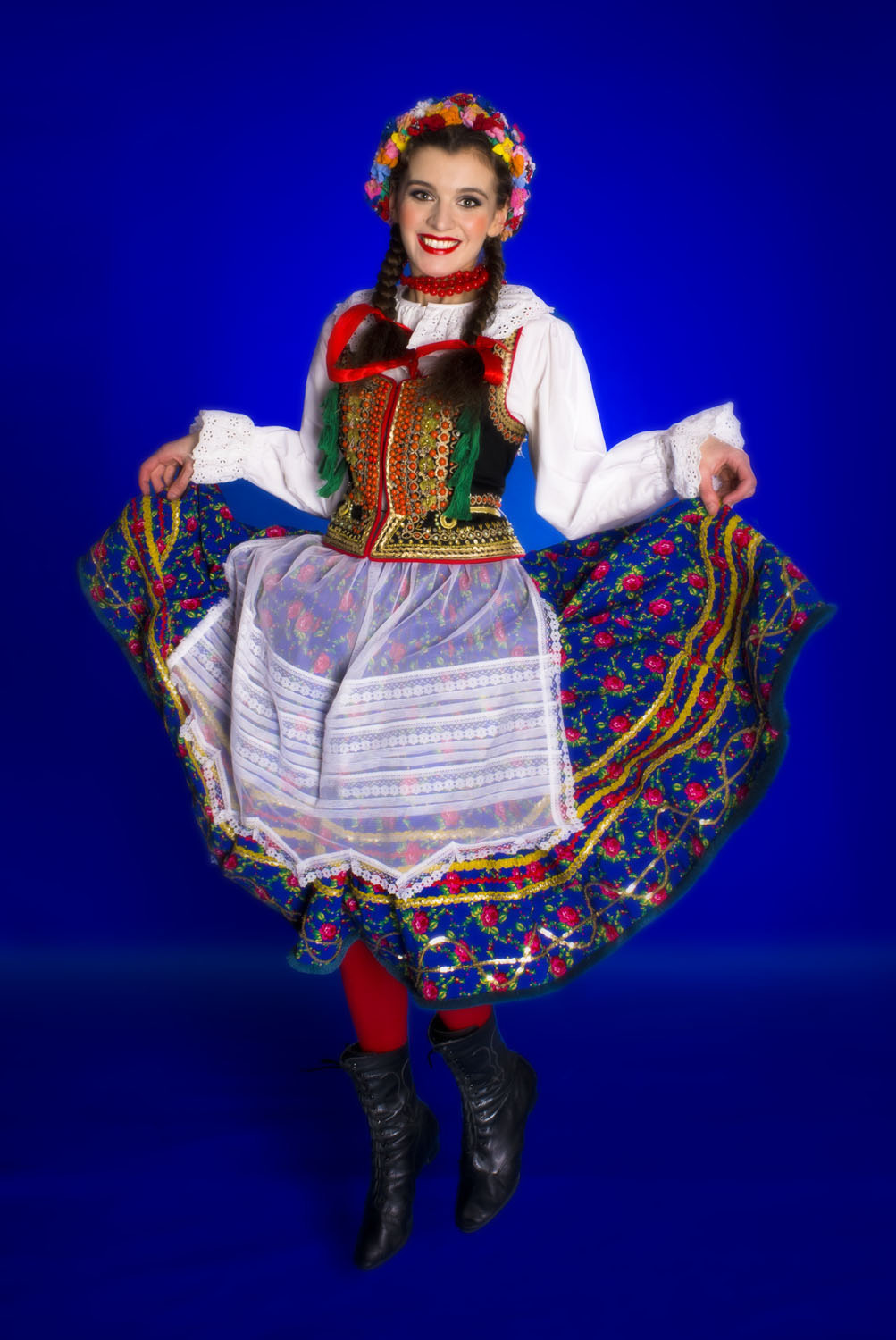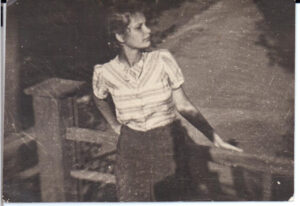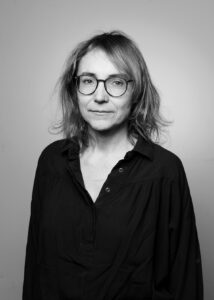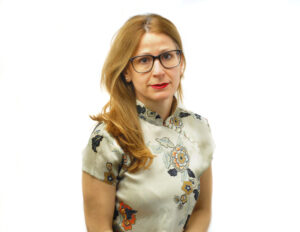Irena Kalicka
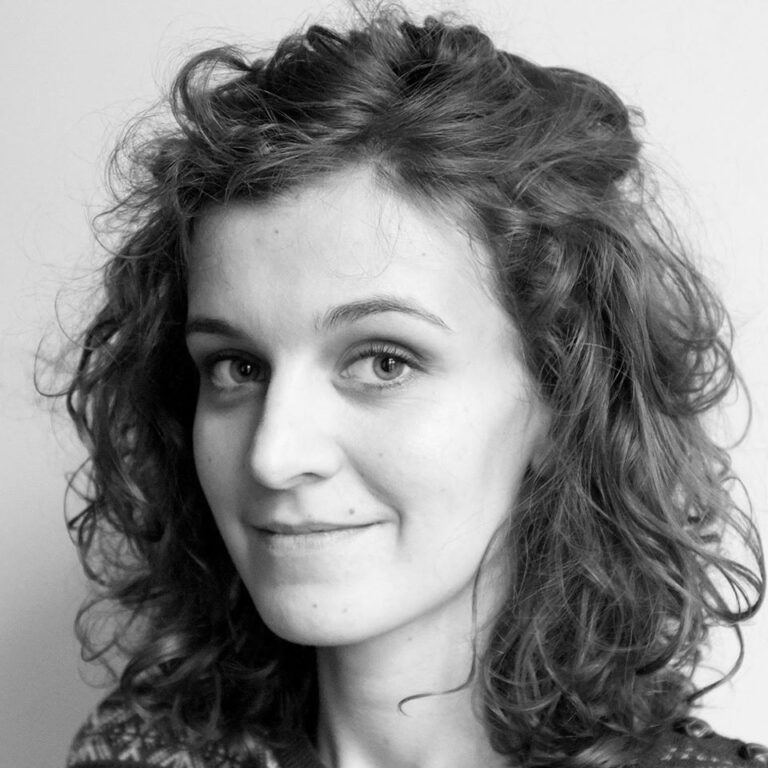
– born in 1986, Krakow – is a photographer.She attended an art high school in Cracow, then studied photography at the National Higher School of Theatre and Television in Łódź. Her first significant series of photographs, as part of her bachelor’s thesis, was Negative Self-Portrait. She creates photographic tableaux vivants – animated representations of canonical motifs from art history – in which the artist herself poses with her friends. Her works also refer to literary and anthropological texts, with numerous symbols, self-quotations, and mythological, religious or pop culture references. She willingly mixes orders and registers, not shying away from kitsch or the aesthetics of intentional error. She uses the stylised form to address contemporary themes related to identity and its stereotypical perception. She lives and works in Krakow.
I deal mainly with photography, all the time dreaming that one day I will make a film, a feature one! I treat each of my photographic series as a closed whole, sometimes I want to return to one of the series and enrich it with new images, but I never do that. In my work I like the moment when I start something new, when the idea is not yet defined. Then I have a lot of energy and conviction that this time I will be able to take a completely different direction, to break through my barriers. My works are comedic in nature, I think that’s why people often don’t take them seriously. For me comedy is very powerful and distance is very important. I have a need to laugh at my own fears, probably not only in my art practice. When I look at my pictures now, I see a lot of violence in them. Violence is what links all my photographic series, often distant from each other in terms of subject or form. I have always touched upon social problems in some way. In my first series such as “Home Photo Theater” and “Self-Portrait”1 I noticed it only years later. “Fototeatrrzyk” [Photo-theatre] was created in the privacy of student apartments and was a kind of game, my friends played bizarre scenes for the camera, some of these situations I tried to direct, but there is much more improvisation than script. I was still in school, quite conservative, and at first I had no intention of showing these works. The theater we played was only ours, it was a kind of safety valve for me, for my friends as well. I think that’s why these pictures have a very sincere character despite their obvious artificiality and theatricality. Today it would be very easy to pigeonhole these photographs as work about exclusion, carnality, minorities. They are definitely the experiences of the people who took part in the theatricality, but the essence of these photographs is elsewhere, difficult to put into words. The moment when my work became more intentional and less intuitive was when I worked on a series of illustrations for the first Polish encyclopedia by Father Chmielowski. “New Athens” considered a negation of the Enlightenment thought or even a clear proof of the darkness of the Saxon times is a fantastic mix of Catholic doctrine, ancient thought, mythology and legends. A vision of the world in which witches and dragons function on a par with the Tower of Babel and Polish monarchs, full of bizarre statements such as “a dragon is hard to defeat, but you have to try.” I did not want to join the critics of Chmielowski, for me the most interesting thing was how much of this absurd thinking about the world has survived in our mentality until today. How stereotypes, prejudices, the way we think about the “other” are created and reinforced. I started working on “New Athens” just before PIS [Law and Justice political party] came to power, and it scares me how up-to-date these photographs have become today. After a long break I am back in the studio now and the first ideas that come to my mind are closely related to Polish politics, I feel angry about that. Kaczynski and the church have invaded my life enough lately. It’s definitely important to have an opinion. Nowadays we have many tools to manifest our opinions and we should do it. But whether an artist uses art to do that is an individual decision. Art is multidimensional and cannot be reduced to commentary and social activism.
Other relevant works for me:23.
The text was written in cooperation with Karolina Maria Rojek (2020).
1Image: Irena Kalicka, untitled, “Self-portrait” series, 2009-2010. Courtesy of the artist.2Image: Irena Kalicka, untitled, "What's done is done" series, 2013. Courtesy of the artist.
3Image: Irena Kalicka, untitled, “Things are what they are” series, 2015. Courtesy of the artist.
– urodzona w 1986, Kraków – jest fotografką. Uczęszczała do liceum plastycznego w Krakowie, następnie studiowała fotografię na PWSTiTV w Łodzi. Pierwszym jej znaczącym cyklem fotografii, w ramach pracy licencjackiej, był Autoportret Negatywny. Tworzy fotograficzne tableaux vivants – ożywione przedstawienia kanonicznych motywów z historii sztuki – w których pozuje sama artystka razem z przyjaciółmi. W swoich pracach nawiązuje również do tekstów literackich i antropologicznych, pojawiają się w nich liczne symbole, autocytaty, i odniesienia mitologiczne, religijne czy popkulturowe. Chętnie miesza porządki i rejestry, nie stroniąc od kiczu czy estetyki zamierzonego błędu. Stylizowana forma służy jej do poruszania współczesnych tematów, związanych z tożsamością i jej stereotypowym postrzeganiem. Mieszka i pracuje w Krakowie.
Zajmuję się głównie fotografią cały czas marząc, że kiedyś zrobię film, pełnometrażowy! Każdą moją fotograficzną serię traktuję jako zamkniętą całość, czasem mam ochotę powrócić do któregoś z cykli i wzbogacić go o nowe zdjęcia, ale nigdy tego nie robię. W swojej pracy lubię moment kiedy zaczynam coś nowego, kiedy pomysł nie jest jeszcze sprecyzowany. Mam wtedy mnóstwo energii i przekonanie, że tym razem uda mi się obrać zupełnie inny kierunek, przebić przez swoje bariery. Moje prace mają komediowy charakter, myślę, że przez to często ludzie nie traktują ich poważnie. Dla mnie komedia ma dużą siłę, a dystans jest bardzo ważny. Mam potrzebę obśmiania własnych lęków, chyba nie tylko w praktyce artystycznej. Kiedy patrzę na moje zdjęcia teraz, widzę w nich dużo przemocy. Przemoc jest tym, co łączy wszystkie moje serie fotograficzne, często odległe od siebie tematycznie czy formalnie. Zawsze w jakiś sposób dotykałam problemów społecznych. W pierwszych moich seriach takich jak „Fototeatrzyk domowy” i „Autoportret”1 zauważyłam to dopiero po latach. „Fototeatrzyk” powstawał w zaciszu studenckich mieszkań i był pewną zabawą, moi przyjaciele odgrywali do aparatu dziwaczne scenki, niektóre z tych sytuacji starałam się reżyserować, ale o wiele więcej jest tam improwizacji niż scenariusza. Byłam jeszcze w szkole, dość konserwatywnej i na początku nie miałam zamiaru pokazywać tych prac. Teatrzyk, w który się bawiliśmy był tylko nasz, dla mnie był rodzajem wentylu, dla moich przyjaciół także. Myślę, że dzięki temu te zdjęcia mają bardzo szczery charakter pomimo swojej oczywistej sztuczności i teatralności. Dzisiaj bardzo łatwo można by zaszufladkować te fotografie jako pracę o wykluczeniu, cielesności, o mniejszościach. Zdecydowanie są to doświadczenia ludzi, którzy w teatrzyku brali udział, ale istota tych zdjęć jest gdzie indziej, trudno ująć ją w słowa. Moment, w którym moje prace stały się bardziej intencjonalne a mniej intuicyjne to czas kiedy pracowałam nad serią ilustracji do pierwszej polskiej encyklopedii autorstwa księdza Chmielowskiego. „Nowe Ateny” uznawane za zaprzeczenie myśli oświeceniowej czy wręcz jaskrawy dowód ciemnoty czasów saskich są fantastycznym miksem doktryny katolickiej, myśli antycznej, mitologii i legend. Wizją świata, w której czarownice i smoki funkcjonują na równi z wieżą Babel i polskimi monarchami, pełną kuriozalnych stwierdzeń typu „smoka pokonać trudno, ale starać się trzeba”. Nie chciałam dołączyć do krytyków Chmielowskiego, dla mnie najbardziej interesujące było to jak wiele z tego absurdalnego myślenia o świecie przetrwało w naszej mentalności do dziś. Jak powstają i umacniają się stereotypy, uprzedzenia, sposób w jaki myślimy o „innym”. Pracę nad „Nowymi Atenami” zaczęłam na tuż zanim PIS doszedł do władzy, przeraża mnie to jak bardzo te fotografie stały się dzisiaj aktualne. Po długiej przerwie wracam teraz do pracowni i pierwsze pomysły jakie przychodzą mi do głowy są ściśle związane z polską polityką, czuję z tego powodu złość. Wystarczająco mocno Kaczyński i kościół wtargnęli w moje życie ostatnimi czasy. Na pewno istotne jest to żeby mieć opinię. Współcześnie mamy wiele narzędzi żeby manifestować swoje poglądy i powinniśmy to robić. Ale to czy artystka/artysta używa do tego sztuki jest indywidualną decyzją. Sztuka jest wielowymiarowa i nie można jej redukować do komentarza i aktywizmu społecznego.
Inne, istotne dla mnie prace:23.
Tekst powstał we współpracy z Karoliną Marią Rojek (2020).
1Zdjęcie: Irena Kalicka, bez tytułu, seria “Autoportret”, 2009-2010. Dzięki uprzejmości artystki.2Zdjęcie: Irena Kalicka, bez tytułu, seria “Co się stało to się nie odstanie”, 2013. Dzięki uprzejmości artystki.
3Zdjęcie: Irena Kalicka, bez tytułu, seria “Koń jaki jest każdy widzi”, 2015. Dzięki uprzejmości artystki.
